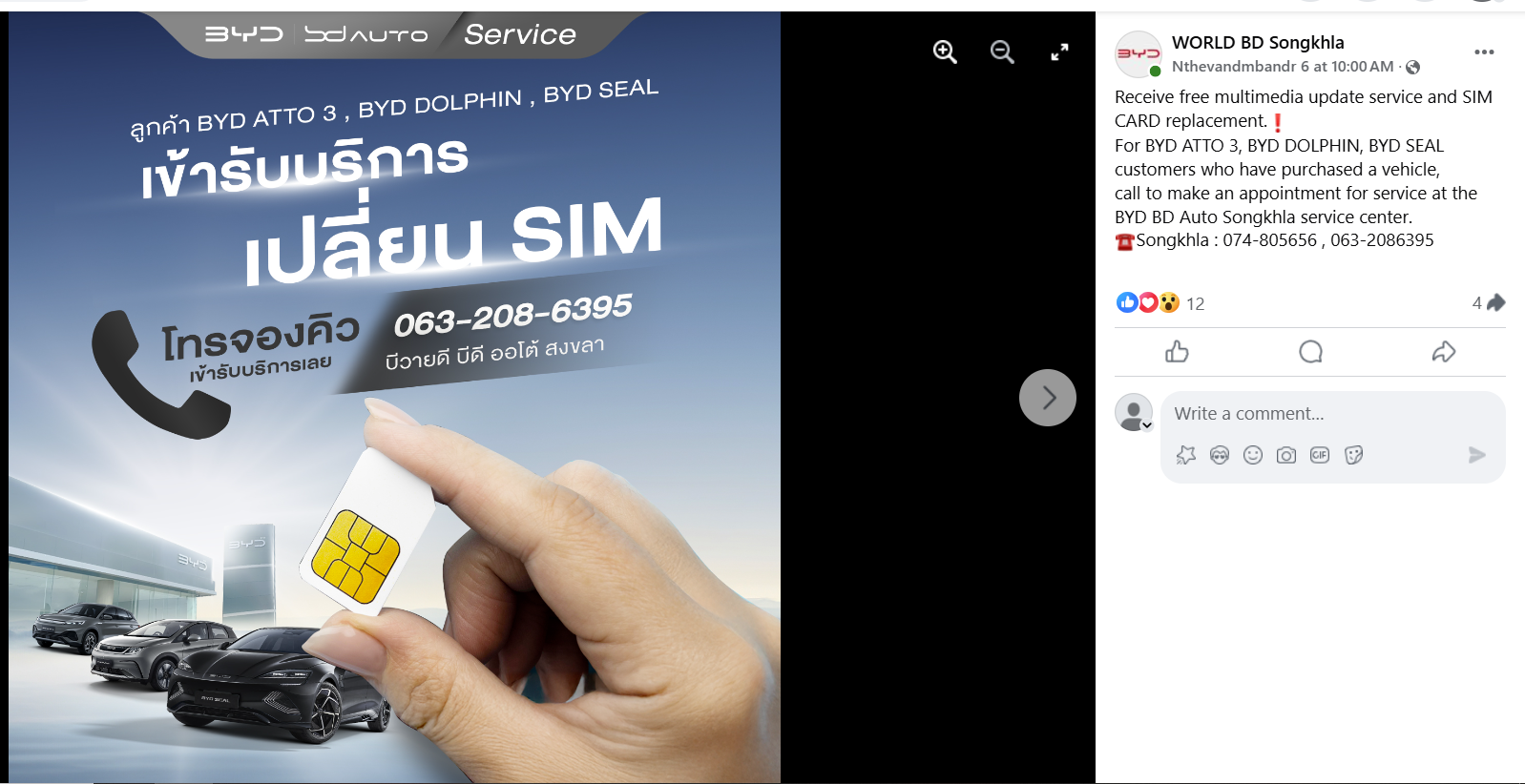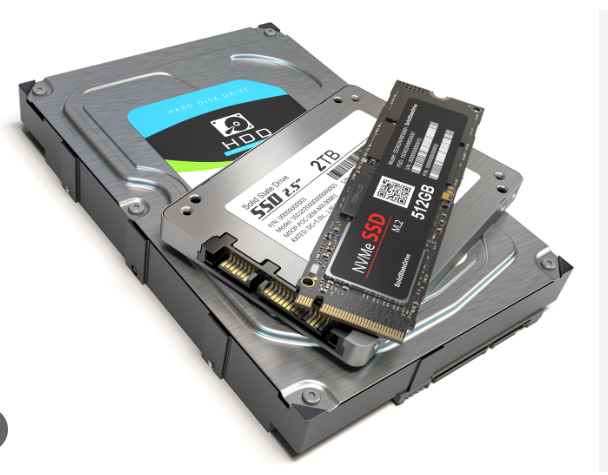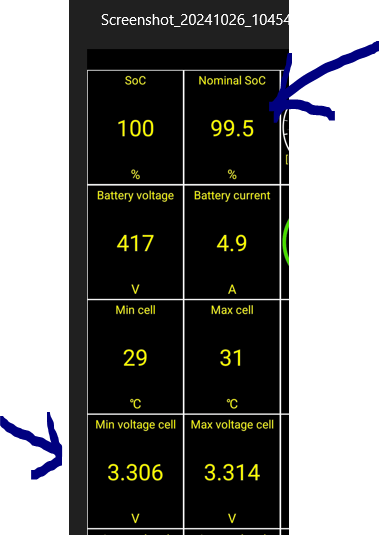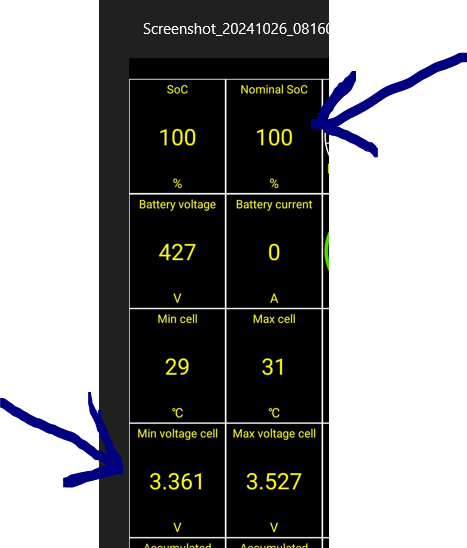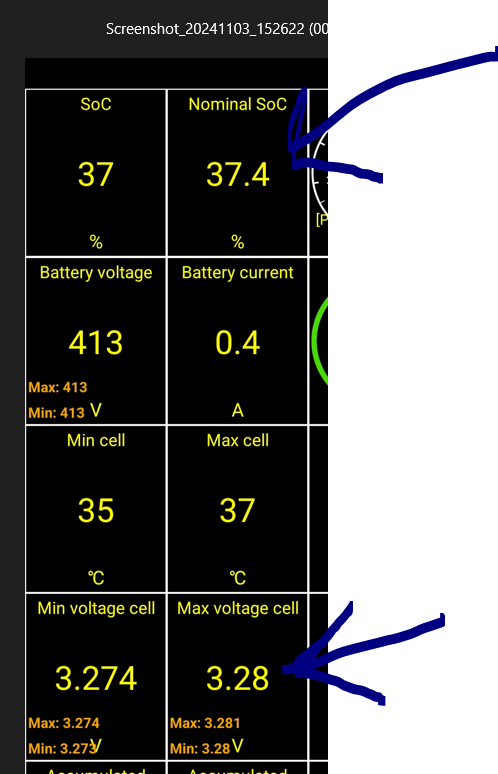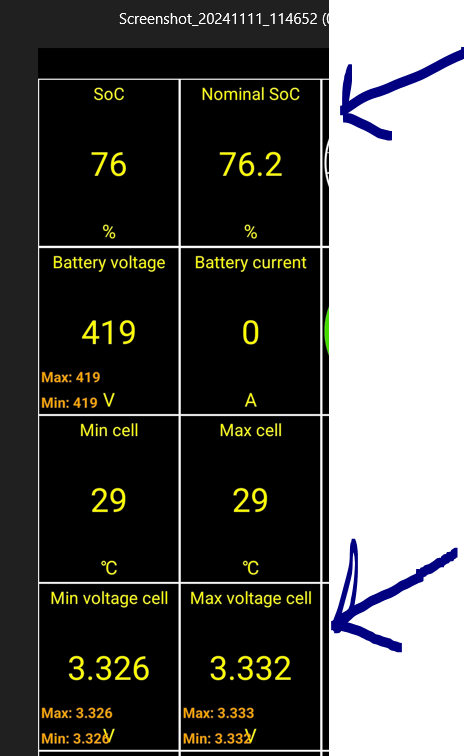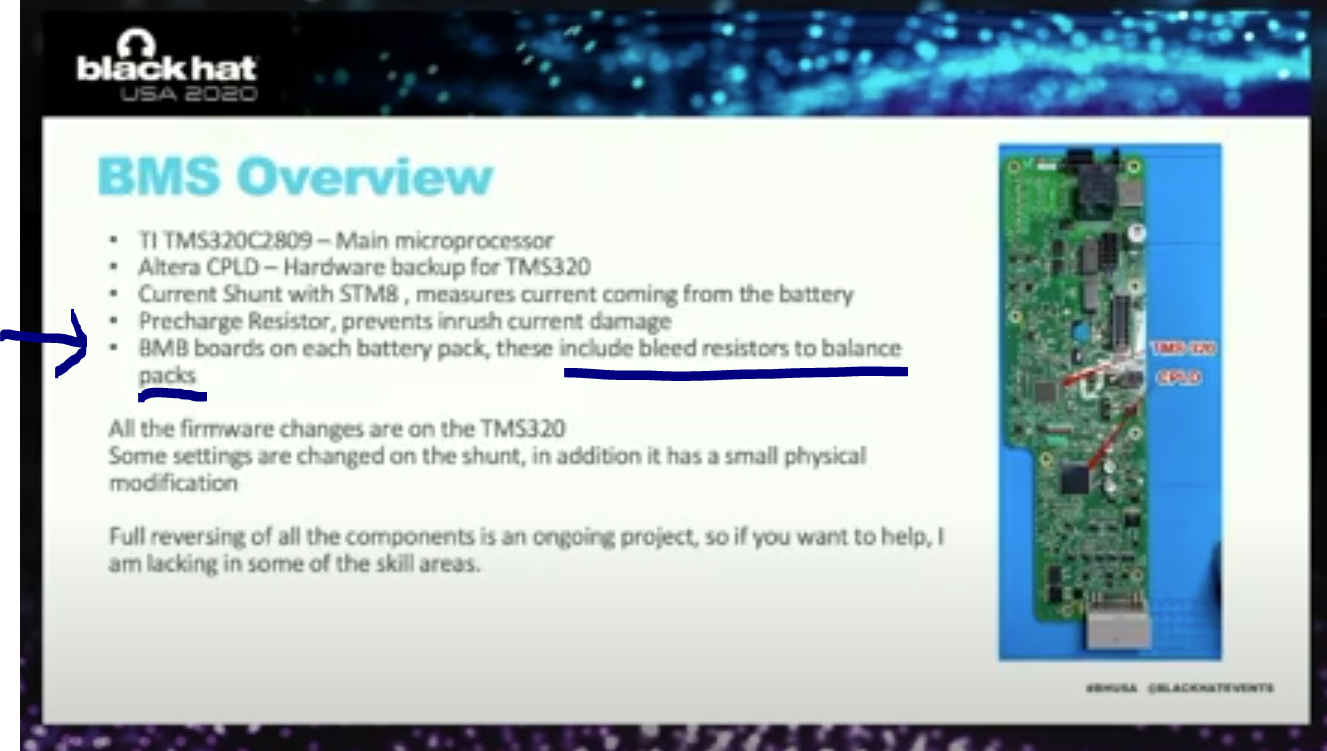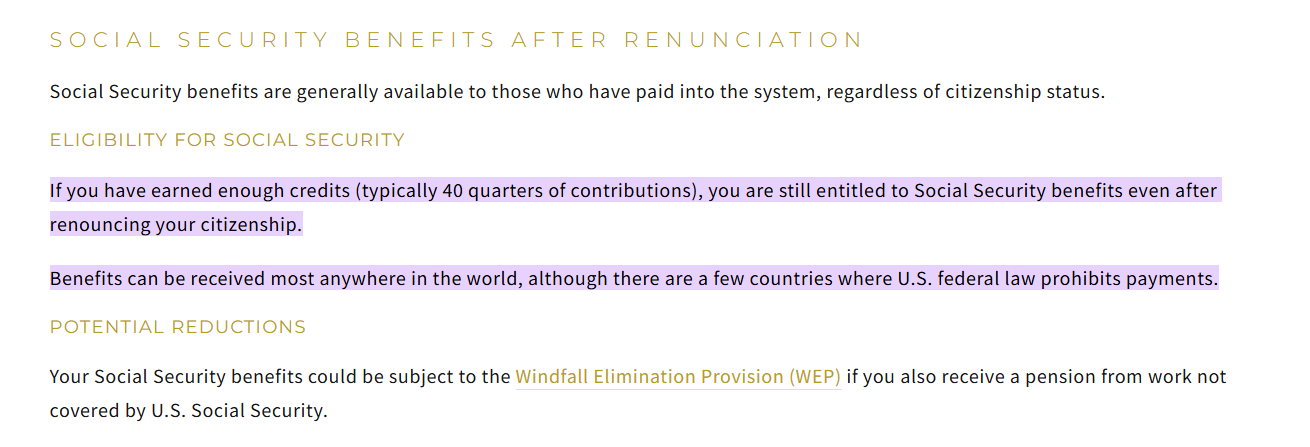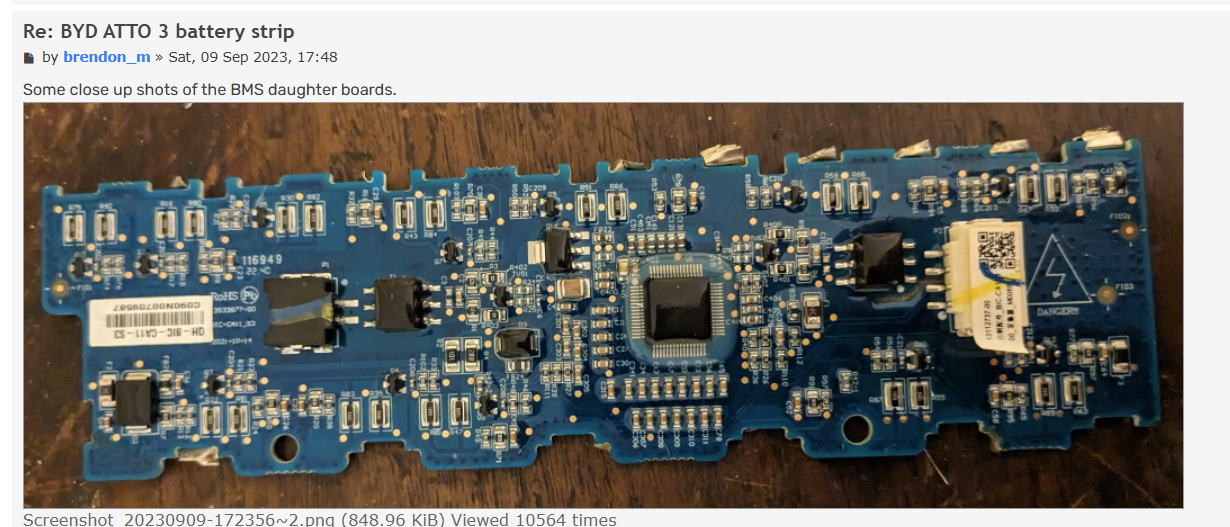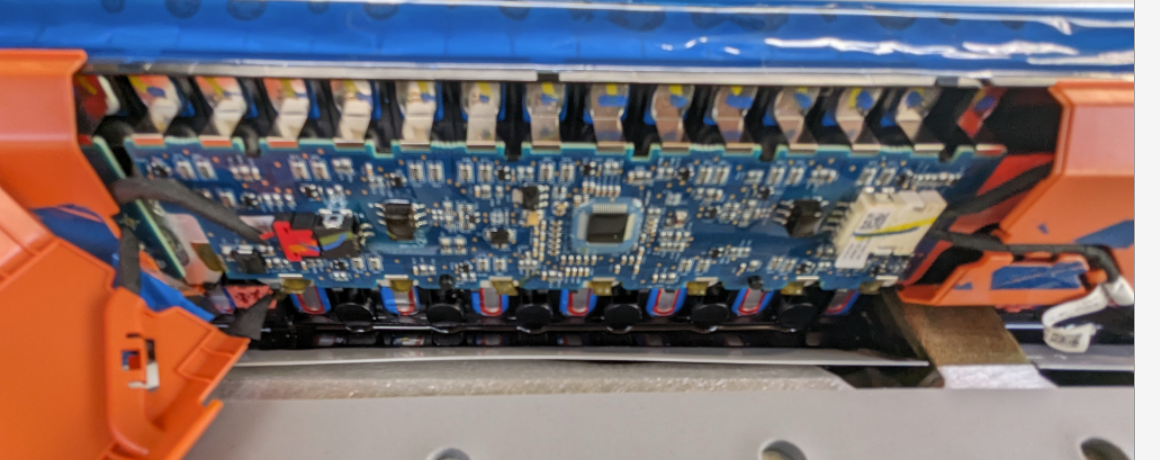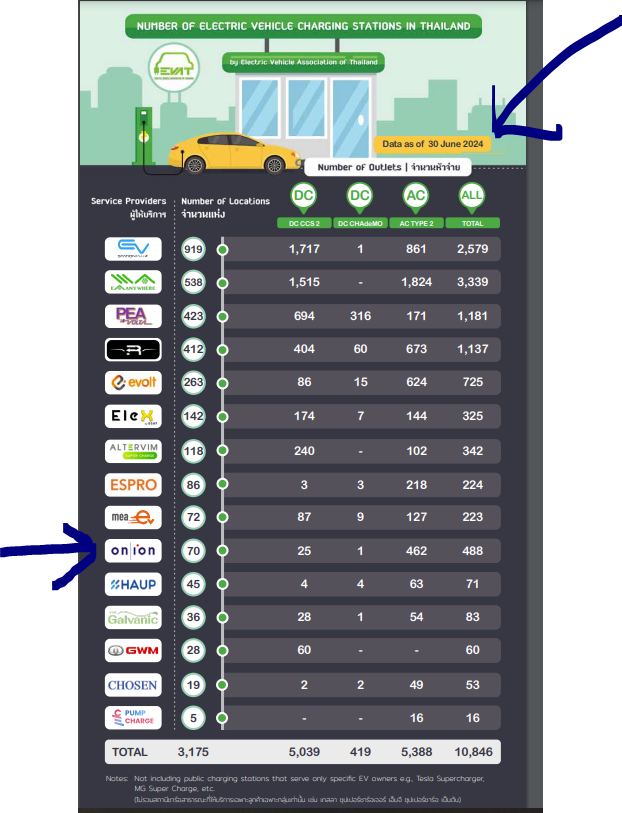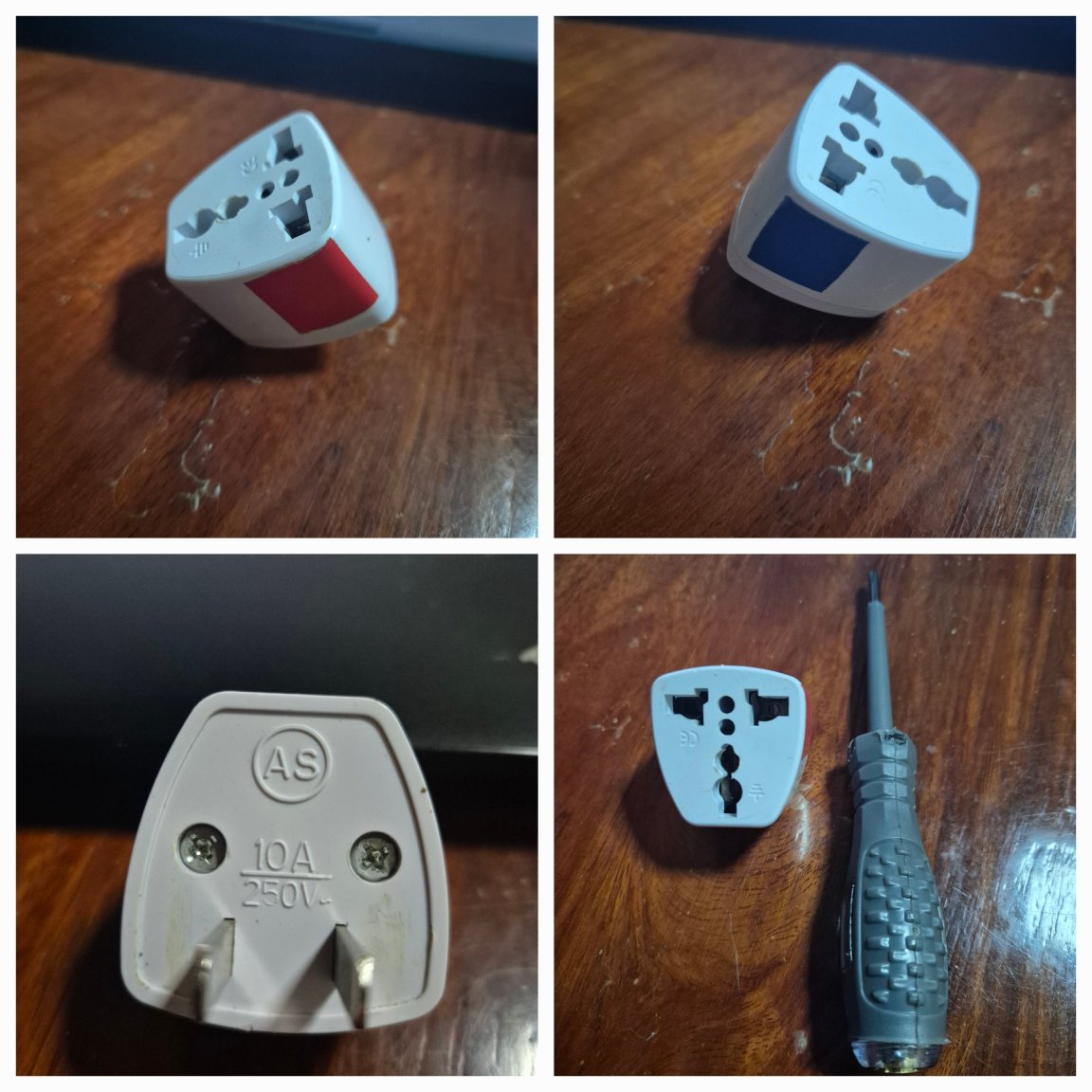-
Posts
29,139 -
Joined
-
Last visited
Content Type
Events
Forums
Downloads
Quizzes
Gallery
Blogs
Everything posted by Pib
-
Yes https://www.ssa.gov/international/payments_outsideUS.html
-
So, if I understand above correctly if a person does the SIM swap/upgrade say with 11 months remaining of the current original SIM 24 subscription then the person's subscription then they will have 14 months remaining? And besides OTA updates stopping after the subscription ends being able to communicate with the EV using the BYD app like to turn on A/C, checking charge level, look doors, etc., from a distance would also probably end assuming the end of the subscription shuts down the SIM completely. I know for a fact from my testing that even if you turn off the Wifi "and" mobile data connections in the car's infotainment system the BYD app is still able to communicate with the car as it's using the SIM's basic mobile text/calling system of the cell network vs the data portion used for connecting to the internet.
-
When I picked up my Atto in Oct 2023 the dealership said the SIM subscription period was for 2 years but BYD was talking about extending it to 3 years...and was still developing a subscription plan as to if it would be free or cost X-amount, etc. . Basically the rep (who could speak a fair amount of English) said BYD was still deciding on how they would handle SIM upgrades, extending subscriptions in Thailand, etc.,...it was still a work in progress.
-
Last night after the Rever Customer Support Chat line closed at 8pm I sent them a message showing above BYD Songkhla SIM upgrade poster. This morming around 11am Rever responded saying: "If you car is approaching 2 years of service, you can get the SIM card replacement service at our service center." A few hours later I went to my Bangkok BYD dealership and showed them a snapshot of the BYD Songkhla SIM poster...and fortunately I was able to speak to a rep who knew some English. He said the SIM swap includes multimedia software upgrade where GBox, Youtube, Netflix, etc., are added. Their service dept made me an appt for two weeks down the road to get it installed...install and software upgrade takes a couple of hours. Most anything my dealership does service-wise takes at least 2 hours (even if it seems to be a 10 minute job)....it's like a 2 hour service window is their minimum for any task of significance. Now I intentionally didn't ask if this SIM swap/upgrade "extends" the 2 year subscription of my current SIM or will the original SIM 2 year period still be ticking for this new SIM....or does a new subscription period of X-years begin. Also didn't ask if it provides more than a 2GB allotment per month. I intentionally didn't ask for more detailed info as the English speaking rep got pulled away to help another customer interested in buying a car.... plus, at this point I just want to get the SIM upgrade soonest even if it don't extended my current 2 year subscription which doesn't expire for another 11 months....I will ask the detailed questions after the SIM upgrade as to remaining subscription period, GB allotment, etc.
-
Yeap...so for any Seal owner the 2 year SIM free subscription would not be expiring before Sep 2025. But after seeing the Facebook page I posted above a few minutes go it appears what the Rever Automotive Help/Talk To Us representative told me during the online chat session may have been incorrect...the representative was apparently talking the typical SIM expiration guidance instead of info regarding the a BYD SIM swap/upgrade program talked about in above SongKhla BYD post. And maybe the Rever Automotive rep simply didn't know anything about SIM swap/upgrade program....missed a company memo so to speak. I will go to my Bangkok BYD dealership over the coming days with the Songkhla Facebook post in-hand and ask for more info such as is it available to me right now for my 2023 Atto and/or is there some fineprint related to the SIM swap/upgrade. This may turn out to be like the free Rat Guard battery modification that I would have never known about unless a Chonburi BYD dealership put info on a Facebook page about it....I don't remember ever seeing anything about it on the Rever webpage....and my dealership never contacted me about its availability. I then went to my Bangkok BYD dealership...asked about the Rate Guard install....and they said yeap and then scheduled the install for a few weeks later. Yeap...this SIM swap/upgrade program once again may be some upgrade BYD does not advertise "widely"; instead, just leaves it up to their local dealerships to get the word out or the customer to find out about thru the grapevine/social media.
-
Snapshot from the a BYD Facebook page....the BYD Sonkhla dealership is advertising the SIM swap/upgrade. This is kinda like how I found out about the Atto/Dolphin Rat Guard free modification from a Chonburi/Pataya BYD Facebook page....and when I went to my Bangkok BYD dealership they schedule an install for me. I'll stop by my dealership here in Bangkok over the coming days and ask....will show them below snapshot. It says it for the Atto, Dolphin, and Seal.
-
A few minutes ago I used the Rever Automotive app to ask under the app's Help "Talk To Use" section about SIM swap/upgrade as there was Facebook chatter about it. I asked them if there is such a SIM swap/upgrade program. And I told them I had a 2023 Atto. I got a response within about 10 minutes saying a person can avail of the SIM card replacement service at the car showroom if your SIM card is nearing the 2 year expiration. Simply provide the VIN number to the showroom and you can schedule an appointment to have the SIM card replaced. Maybe some of this SIM replacement chatter is dealing with those folks who bought their BYD vehicle in 2022/early 2023 which means their SIM card subscription would be expiring soon or recently expired....just guessing. Probably best for a person to visit their dealership and ask face-to-face regarding your specific BYD vehicle.
-
Yea....I take his videos with a HUGE grain of salt. It's not uncommon for him to add a half dozen or so new videos to his channel each day....all of which is him basically expressing his opinion on the newly released news articles. This video is probably based on a China Post article from about a week ago talking CATL "hopes to achieve small scale production by 2027" of this whiz-bang solid state battery. I expect "by 2027" means by 31 Dec 2027 around 3 years from now. So, maybe we would see this whiz-bang solid state battery in some 2028 model EVs. And maybe Toyota's imaginary solid state battery they have been talking for years and years already will be out before 2027 if they can ever break their addiction to old technology NiMH Nickel Medal Hydride batteries. https://interestingengineering.com/energy/china-catl-solid-state-battery-production-by-2027 Updated: Nov 07, 2024 05:21 AM EST CATL goes all in for 500 Wh/kg solid-state EV battery mass production CATL’s prototype solid-state batteries have an impressive energy density of 500 Wh/kg, a 40 percent improvement over current lithium-ion batteries that typically reach 350 Wh/kg. China’s Contemporary Amperex Technology Co., Limited (CATL), a global leader in lithium-ion battery development and manufacturing, is significantly escalating its investment in all-solid-state battery technology. A Chinese local media outlet, Late Post, has reported that the company aims to achieve small-scale volume production of its all-solid-state battery by 2027.
-
See below 16 Oct 2024 CNBC news article regarding solid state batteries and how semi-solid state batteries may be in our future. Partial quote below and full article at the weblink. Maybe the stepping stone to solid state batteries will be semi-solid state batteries. https://www.cnbc.com/2024/10/16/the-race-for-next-gen-ev-batteries-may-soon-pivot-to-semi-solid-state.html The solid-state batteries hype is fading – prompting auto giants to consider alternatives Key Points Solid-state batteries have long been billed as the “holy grail” of sustainable driving. Proponents say they offer safer, cheaper and more powerful batteries for electric vehicles (EVs), as well as faster charging times. There could be another option, however: semi-solid-state batteries, which use a hybrid design of solid electrolyte and liquid electrolyte. “Five years ago, if we talked about this, I would have been so excited about solid-state batteries,” Transport & Environment’s Julia Poliscanova said. “But somehow ... there is some kind of barrier today.”
-
I've lost track of how many times the Electric Viking has started off his videos by saying: ".....it's game, set, match...." regarding EVs killing off ICEVs sooner vs later due to some announcement of improved technology by some battery maker or EV maker. I agree that solid state batteries will be a game changer but how fast their widespread availability/use occurs is probably more than just a few years away....I'm guessing around 5 years is more realistic. I figure it will be similar to the hard drive to solid state drive (SSD) to M2 drive transition that took around 10 years for widespread transition to SSD and then to M2 even though HHDs are still being made mostly for data centers and cheap storage. But I did like the Electric Viking's statement that this CATL solid state battery announcement is not like the Toyota's "imaginary" solid state battery that Toyota has being talking near term release for years and years now. 😁
-
My goodness is the cut-throat EV price war coming to an end....maybe moving into a slower pace trench warfare phase. See below 11 Nov AutoLifeThailand article. https://autolifethailand.tv/avatr-no-discount/ AVATR cancels “cash-back” discount campaign to maintain brand image Mr. Anuwat Inthraphuwasak, Chairman of the Executive Board of Infinite Automobile Co., Ltd., revealed that from the joint meeting of " Infinite Automobile " and " Eternity At One " as the official distributor of premium electric cars under the brand AVATR ( Avatar ) , the latest conclusion is to cancel the provision of cash discounts and marketing activities related to cash back discounts to maintain the image of the premium brand. Previously, Chang'an Auto Southeast Asia Co., Ltd., the parent company, announced a sales promotion ( promotion ) to provide a cash discount of 100,000 baht during the launch in September, limited to 200 cars, which has been fully paid out. In October, there was a cash discount campaign of 60,000 baht, which the original plan was to provide this discount until the end of 2024 . Read related news: AVATR distributor is generous! Pays 10 million to give discounts to customers who exceed the first lot quota. The cancellation is expected to be officially announced at the latest during the upcoming Motor Expo 2024, or at the earliest on November 15 , 2024 . While from now on, it will focus on presenting the brand's premium luxury and technology that meets the needs of consumers, which is confident that it can compete with competitors in the same level in the market. However, the supply of the first batch of AVATR 11 to enter the country is currently 500 units. There is a shortage of some supplies, with the first batch of only about 300 units. We are in the process of expediting understanding with consumers and finding solutions to achieve maximum satisfaction.
-
EV Owners … Real life experience & help thread
Pib replied to KhunLA's topic in Thailand Motor Discussion
I"m going to guess that although the MG BMS indicates 100% once a certain cell voltage is reached for a few seconds---a voltage such as at least 3.65V which is generally considered the 100% charged voltage level for a LFP cell---the BMS knows that even when 3.65V is initially reached if continuing to charge at a constant voltage of 3.65V but at a low current (i.e., just an amp or two) for X-period of time the battery can still absorb a little more capacity (maybe a percent or two) without damage to the cell and also help in the cells balancing process. The BMS might be programmed to continue charging X-amount additional minutes (like maybe 20 minutes, 30 minutes, etc) after reaching 3.65V average cell voltage. OR, it might be programmed to continue charging at a "low" current level...lets just say 1 or 2A for discussion purposes....and it will then continue tapering "down" that amperage level to around a few tenths of an amp and let's say completely stop charging when the current reaches 0.2A as the battery capacity is now full-full. This on-top absorption period (i.e., when initially reaching 3.65V which represent 100% charged) is not to be confused with the main/primary/long absorption period on the way to reaching a certain voltage level like 3.65V. And a LFP cell can still be charged to 100% KWH/AH capacity even if not allowing it to reach 3.65V but instead just charging at 3.45V "for a longer time" which is increasing the absorption period. But if not wanting to take extra time to maximize charge capacity then allowing it to charge up to 3.65V gets the charging done faster. I expect EV manufacturers know their EV customers want the charging done as quick as possible and the way to do that is to allow cell charging up to 3.65V versus only allowing 3.45V or 3.55V with an extended, low amperage charge period. MG may have found a good compromise in showing 100% charged which is when most drivers would probably unhook the charger to continue their trip OR if the customer can wait a little longer to let the battery continue to charge at a low amperage level (i.e., that top-in extra absorption period) then the battery can take in a little more capacity (maybe get a little more Km range from a cell balancing/adding just a little more KWH capacity) although the charge percentage will not increase above 100%....and maybe even the Km range will not increase but as you drive along it's actually decreasing at a slightly slower rate since the battery took a little more capacity from that extra absorption period. There are different ways at different voltage and current levels to fully charge a 3.2V LFP or 3.6 NMC cell. I expect battery/EV manufacturers have different opinions on how they will build and charge their BMS and battery pack. Edit: oh, just remembered, regarding my BYD Atto final bit of charging. From monitoring OBD2 data while DC and/or AC charging and the percent charged indicator on the car is displaying 99% you can tell that very soon it's going to change from 99% to 100" when the "calculating...." message starts displaying which I assume means the the system is recalculating/recalibrating the BMS and charge percentage indication system. Although going from 99 to 100% takes around 5 minutes on a 7KW wall charger at around the 1 to 2 minutes to go point the "calculating...." message appears and this always seems to appear when the cell with the lowest voltage finally reaches 3.55V, repeat, 3.55V, for at least a few seconds while the cell with the max voltage is usually indicating around 3.65-3.75 volts. That "calculating..." message does not appear until the cell with the lowest voltage reaches 3.55V for a few seconds....then just a minute or so later the charging stops. And if using a DC charger that same 3.55V min cell voltage still applies regarding appearance of the "calculating...." message, but since you are still pumping in a higher current than a wall charger would be the charging completes within 15 to 30 seconds. 100% finally appears and zero charging current is occurring. So, it seems BYD's approach is to get "each & every" cell of the battery pack (126 cells in my 60.5/KWH battery pack) up to at least 3.55V and then it considers the pack fully charged....time to start "recalculating /recalibrating" the BMS system. And from googling/watching YT videos it seems 3.55V is a very popular max cell charging voltage in the DIY home solar community as it's considered to have brought a cell to full 100% and will have been enough voltage to properly balance it when that cell is just one of many cells comprising a battery pack where there is always going to be a little bit of cell imbalance. -
EV Owners … Real life experience & help thread
Pib replied to KhunLA's topic in Thailand Motor Discussion
Below are some snapshots of my BYD Atto battery pack OBD2 data monitoring over recent months relating to cells balance.....see the words I added above each snapshot for more info. My words concentrate on cells imbalance between the 126 blade cells in the Atto's 60.5KWH battery pack ************************ Just finished charging the Atto to 100% using a DC Fast Charger on 26 Oct 2024. At the instance charging completes/now at 100% the 126 LFP blade cells imbalance (a.k.a. delta) is 166mv. Normal balance would be under 10mv based on my OBD2 data monitoring over numerous months.. But I already know the high imbalance is predominately "surface charge" that has very, very little capacity and will dissipate very quickly under normal battery load.....just like it happens on a ol' 12V lead acid battery right after you finish fully charging it. Now after charging to 100% I wanted to see how long it took for the cell imbalance to get back around it's 7mv as I drove away. After driving around 4Km/5 minutes on 26 Oct the cells balance among all 126 cells in the Atto battery pack is now back within 7mv as that surface charge was quickly dissipated. Since I have been charging to 100% approx once per week which recalibrates the charge percentage/range display/BMS the cells have stayed in excellent balance which is a good thing. But how much imbalance is too much? 10mv, 100mv, 200mv, etc? Well, from tons of googling and watching way too many Youtube videos (both bad and good videos) I'm still not sure at what millivolt imbalance is considered too high "when the battery is under normal load or been setting static/unloaded for a while." A lot of websites/Youtube videos related to DIY home solar/DIY electric vehicles indicate that most cell balancers don't activate until an imbalance of 100 or 200mv is reached...then they activate to attempt to bring cell balance back to within a certain range over a few hours to maybe over several days. At one time I did stumble upon a conversation on BYD EV battery pack cells balance where several people was saying their battery imbalance was 20mv, another one said 10mv, another one 6mv, etc....and they were wondering how much is too much. Several people mentioned it should be within 100 or 200mv based on what they know (or think they understood) about home solar battery storage systems but really didn't know what an EV battery should be. Then one guy entered the conversation for just a few posts who said he worked as an engineer at BYD for several years and said 60mv is the spec BYD uses for a LFP blade battery that has balanced/operating under normal/steady loading conditions. Was this supposedly former engineer (of some type) who worked at BYD correct or not....I don't know as he didn't post any reference to authoritative BYD published docs/specs which would probably be proprietary data. And finally, he's a 11 Nov 2024 snapshot from just a few minutes ago as my Atto sets in my carport getting reading to be turned on an make a morning groceries run to Lotus. Cells imbalance is a mere 6mv. Once I turn the Atto on the cells imbalance will be around 7mv...and while I drive along with a steady foot on the fuel pedal it will vary a little but stay under 10mv. But if I press the pedal to briefly over-take another vehicle the cell imbalance will "very" briefly jump up to around 50mv and then with a few seconds come back to under 10mv...right around 7mv as I steadily drive along Da end. -
EV Owners … Real life experience & help thread
Pib replied to KhunLA's topic in Thailand Motor Discussion
While many websites talk how active balancing is better in some ways than passive balancing and some of these website sites state/imply is good for EV battery packs I haven't found one yet that specifically states that EV model so-in-so uses active balancing (excluding a few websites which shows disassembly of a battery pack/reverse engineering a BMS to really see what type of balancing is apparently being used). Like say the BYD EV battery packs in the Atto, Seal, Dolphin, etc., use active balancing per BYD provided documentation/specs. Or Tesla battery packs like in the Model S Plaid use active balancing, etc., per Tesla documentation/specs. It seems most of these websites are just expressing an opinion or generalizations that for those actively involved in DIY home solar battery storage systems; DIY electric vehicles (EV) which could really mean a home-made EV bike, EV golf cart, etc.; EV cars probably use active balancing since active balancing vs passive balancing is probably better, etc.;, that if you want the best balancing then go with active balancing which uses a more complicated BMS systems, chips, inductors, capacitors, transformers vs the less complicated BMS passive balancing system that is less complicated, lower cost, uses simple bleed resistors, etc. And this is not to imply passive balancing is not OK-fine and active balancing "may" be a little better and faster.....a faster and better that person may not actually be able to really see or benefit from in their day-to-day use of these "battery powered" system. Since I mentioned Tesla EVs....what kind of balancing do they use....active or passive? I doubt you'll find any Tesla-provided documentation/specs that specifically states what is used since it's apparently proprietary information. But a person can usually find some website where someone has reverse engineered, disassembled an EV manufacturer's battery pack and BMS system to determine whether active or passive balancing is being use. Like in above/earlier BYD battery disassembly which shows "passive resistive balancing" is used. And like below Tesla Model S Plaid battery pack/BMS reverse engineering video where it shows the Battery Management daughter boards on the Tesla battery pack use "passive balancing bleed resistors." See below snapshot from the video also posted below....where it talks the balancing used is around the 4:20 point. I'm of the opinion that although active balancing may be better than passive balancing "on paper" and in some applications that does not mean EV vehicles like the BYD, Tesla, MG, etc...etc...etc., cars and trucks driving on the roads today use the more expensive and complicated active balancing in their battery packs. But instead use a simpler and lower cost passive balancing system that still meet cell balancing needs. A passive balancing system that may not be as good/fast as an active balancing system, but still more than good enough, OK-fine, works just fine, etc. to keep the EV battery pack cells balanced and in good condition that exceeds the expected life of the vehicle. -
Leaving USA ? Be aware of 30% tax....
Pib replied to GypsyT's topic in US & Canada Topics and Events
https://bambridgeaccountants.com/us-expat/impact-on-benefits-post-citizenship-renunciation#:~:text=If you have earned enough,U.S. federal law prohibits payments. -
Leaving USA ? Be aware of 30% tax....
Pib replied to GypsyT's topic in US & Canada Topics and Events
Typical talk after an election....if the Democrats won many rightists say they are leaving the U.S.....if the Republicans won many leftists say are leaving the U.S. -
EV Owners … Real life experience & help thread
Pib replied to KhunLA's topic in Thailand Motor Discussion
And just to supplement my above post I think the BYD passive balancing daughter boards are basically larger versions of the resistive balancing board talked below at around 13:52 into the video. I will also add where I mentioned in my earlier post a brief cell balance of around 250mv just before hitting 100% while charging but it quickly goes back to around 7mv, that 250mv brief imbalance is mostly "surface charge" which contains very, very little capacity and is quickly consumed under normal battery load. Same thing happens when you fully charge a good ol' 12V lead acid battery and then immdiately check the voltage which is probably going to be a little over 13 volts...maybe even around 13.5 vs the nominal voltage of around 12.6 to 12.8V. Turn the headlights on for 15 seconds or so and the battery's surface charge will get consumed very quickly and then the measured voltage with headlights off will now be around 12.6 to 12.8V. -
Leaving USA ? Be aware of 30% tax....
Pib replied to GypsyT's topic in US & Canada Topics and Events
As Jingthing already pointed non-U.S. citizens can receive social security....many, many do. They just need to have worked/resided in the U.S. for the required number of years. Heck even a non-U.S. citizen spouse who lived in the U.S. for at least 5 years with their US citizen spouse can get a spousal social security pension even if the non-U.S. citizen never worked/paid social security taxes. The law has been that way for many years. -
EV Owners … Real life experience & help thread
Pib replied to KhunLA's topic in Thailand Motor Discussion
I've been interested over the last month regarding how my BYD Atto 3 LFP 60.5KWH battery is designed for cell balancing. It has 126 cells with each cell being a 152AH cell. Below is a snapshot/partial quote from the website from a guy who bought a wrecked Atto 3 just to get the traction battery which was undamaged, disassembled the battery as much as possible, and converted it to a home solar battery storage pack. Below are some snapshots of one of the BMS daughter boards (10 total such daughter boards plus a motherboard in the front of battery) which indicates it uses passive resistor balancing where two 10 ohm resistors in series for each cell along with a BJT transistor/MOSFET are used for balancing---classic components for a BMS that uses passive resistor balancing. So on any motherboard that manages 14 cells you'll count 28 ten ohm resistors on heat dissipation pads and 14 nearby MOSFETs along with other components. You will also notice no bank of inductors (like 14 inductors instead of 14 resistors), capacitors (like 14 capacitors instead of 14 resistors), or a transformer on the daughter boards which would indicate "active balancing." And this passive balancing works really well according to OBD2 data on my Atto. I've monitored the Cell Voltage Delta/Balance for weeks now....it's typically has a cell balance/delta of only 7 millivolts while idling, driving steadily, and charging although at around 99% charged while charging the cell balance will go to approx 250mv briefly, but after charging completes at 100% charge the balance quickly returns to approx 7mv after just a couple kilometers/around 10 minutes of driving....when reaching approx 99.5% charge level. I expect the BYD Dolphin and Seal (and similar BYD BEVs) use the same passive balancing approach. https://forums.aeva.asn.au/viewtopic.php?t=8323 Snapshots of an BMS daughter board from an Atto battery. The cells have BMS boards covering the terminals down the right side (drivers side in RHD countries). The boards span 12 and 14 sets of cells (3x 14s boards and 7x 12s boards) and appear to be powered from the cells themselves as there are only 2 data wires coming out of the contactor block at the front and linking each board in a daisy chain fashion. Each board also has a temperature probe going into the cells. The lower edge of the board has the inputs from the busbars and they get passed through to the upper edge. This is along circuit tracks on the underside of the board. Then there are vias that take the traces through to the top of the board to all the balancing guff. The balancing guff consists of a transistor and 2x 10 Ohm resistors in series with each other. The upper edge of the board has the inputs from the terminals on the cells that go to the other side of the pack. Strangely enough it also has nickel strips that link the near side busbars to the other side of the pack. But then they aren't connected to anything. -
The wife and I did our DLT eLearning training a few months ago to renew our license. From looking at the QR code certificates I saved on my phone per Google Translate at the top it says in black letters "Please save to display this QR code on the day of service at the transportation office". Then it has the QR code and also a long long reference code beneath the code. Then it has what ID number like Thai ID card, Pink ID card, or Passport that you used. Then it says: "Trained. Renew personal car driving license" Then is shows the training date. And finally at the bottom in red text is says: "*Training results are valid for 6 months from date of training"
-
Leaving USA ? Be aware of 30% tax....
Pib replied to GypsyT's topic in US & Canada Topics and Events
Below provides more details....nothing new about this....it only applies when a person meets the right conditions. https://www.gfp.institute/post/how-the-us-exit-tax-is-calculated-for-covered-expatriates -
Just installed the iGreen charging network app. No need to register to see their charging locations and number of chargers at each location. iGreen chargers are predominately in the greater Bangkok area. When using the app to show/filter AC "and" DC charging "locations" it gives a total of 161 locations. But when selecting to show locations with AC chargers it lists 157 locations. So the great majority of the 161 locations have AC chargers but they may also have DC chargers. When selecting show me DC chargers it lists 59 locations out of the 161 locations. So, I guess that means of the 161 locations iGreen has AC and/or DC chargers but of those 161 locations only 59 of them have DC chargers with the great majority those DC charging locations being in the greater Bangkok area. 4 DC charging locations in the Chonburi/Pattaya area....3 DC charging locations in the Chiang Mai area....and then just a few more DC charging location in a few other areas. Now I've been talking "locations".....each location has multiple AC and/or DC chargers totaling up to hundreds of chargers....maybe approaching approx 500 chargers across the 161 locations. Some locations have 2 DC chargers and 3 AC chargers. Where I mentioned in my other post I first notice iGreen chargers at the Foodland I go to in Bangkok, well, that location has 2 AC chargers and 2 DC chargers. It looks like the only payment option is debit/credit card....don't know if it only accepts "Thai" debit/credit cards or foreign cards also. The card is used to top-up your iGreen wallet...then payment for each charging session is deducted from the iGreen wallet. So if you want to start a charging session you will need to use your card to top-up your iGreen wallet. Still thinking if I want to register. Since the great majority of their DC chargers are in the greater Bangkok area where I live that doesn't do "me" much good for long trips away from home. But for someone who say lives a couple hundred kilometers outside of Bangkok and will be making frequent trips to Bangkok then that would be a good thing for them recharging-wise. Each person is different as to where they need/want to see DC chargers.
-
I registered with below charging networks since they are the top 6 in terms of number of DC chargers. And I have used all of them mostly for testing purposes...ensure they "really" work for me....get use to using each one. They all operate pretty close the same way...just minor differences. Now I have used the ReverSharger network around 50 times since early August as I can charge for free thru 2 Jan 2025...so, I stop and top-up often in my day-to-day....get as many free electrons as I can while they are free. Charging Apps I'm Registered With - PTT EV Station Pluz - PEA Volta - EA Anywhere - Elexa - Altervim - ReverSharger More and more PTT stations seem to be adding chargers and lord knows PTT stations are almost everywhere on main roads. And it not uncommon for a some PTT stations to have charger but they will not have an EV emblem on their big road sign. ALWAYS use the charging apps to see where their chargers are...do not expect there to be some big neon sign along the road saying there is a charger at this location----use the apps.....lots of chargers in many locations. Sure, some Thailand locations have few public chargers (especially rural areas) but for long trips via main roads there is enough DC chargers to get to where you are going. I rarely have a need to use a DC charger since I have a wall charger and my Atto has a real world range of 400-440Km (BYD advertised NEDC range of 480Km or WLTP 420Km). It's not like I'm doing daily/weekly Bangkok-Pattaya road trips....the great, great, great bulk of my driving does not exceed a 150Km "radius." With that 400-440Km real-world range I can drive around a 200km "radius" from my home without needing to recharge if I wanted to run down close to 0% charge before getting back home...but I'm not that stupid. ...when on a long trip I always plan a recharge/top-up to ensure I have at least 25% remaining when getting home/going to whatever location I'm going to. And I will stop and charge for say 20 minutes while me and the wife take a bathroom break, grab a snack/bit to eat, etc....I may have zero need to charge while making that bathroom stop but since there is a DC charger there why not do a top-up...not necessarily to 100%...maybe just do 20 minutes of charging. After 13 months of driving my Atto the little bit of range anxiety I initially had has long disappeared because of so many places for me to charge,,,and because of the range of my Atto. And heck, people driving around in BEVs which have around a 600Km range probably laugh when someone says "range anxiety." For the charging apps that require a debit/credit card for payment only the ReverSharger app would not accept my Bangkok Bank Mastercard debit card, but gladly accepted my foreign credit card. Some apps don't even require a credit card as they offer the QR payment method.....some offer debit/credit card and QR payment....and some use the Wallet approach where you put money in the app's wallet via top-up from debit/credit card or QR payment. Whatever app you register with be sure to determine what "payment option(s) they offer....don't do much good to be able to register but can't add a payment option....if you don't have a payment option that you can use then you will not be able to use the app to charge the EV. P.S. When at a small Bangkok mall the other day where the Foodland is that I primarily go to once or twice a week they just finished installing some "iGreen" DC and AC chargers. A new charging company not listed on above chart....new charging companies popping up all the time. I'll probably install their app to see if they are worth signing up with....see their website below with links for app download/install. https://igreenplus.co.th/
-
Onion chargers have been around for a while....they are mostly Level 2, 7KW or 22KW "AC" chargers....Onion has few DC Chargers. I see them periodically in malls here in Bangkok like at Central Malls. https://evat.or.th/ev-information/current-status/index
-
And below is my poorly made and very short video of above homemade "pass-thru bonded neutral-ground adapter" charging my Atto. Please note I have already used my voltage detector screwdriver to determine which is the hot/live hole and neutral hole on my carport socket (A VERY IMPORTANT, MUST DO STEP)....the top hole on the socket is the hot/live hole and bottom hole the neutral....and then I plug-in the 2 prong pass-thru adapter in the correct hot/live and neutral orientation. The charger's power light comes on steady and the charging light begins blinking which means it's charging since I already have the CCS cable connected to the Atto charging port. And the Fault light being off means no fault detected like it detecting it doesn't see any ground since it is seeing a ground due to the pass-thru connector. Since the neutral and ground connectors within the adapter are wired together the portable adapter sees a ground and the charger is happy....it begins charging. If you just plugged the charger's cable into a socket with only 2 wires (hot and neutral) without the pass-thru adapter the charger does not see an earth connections and its the Fault light comes on and it does "not" begin charging. With this BYD portable 10A charger it charges the Atto at a 1.8KWH to 2.2KWH rate depending on the current charge level of your EV. One hour of charging will give approx 3 to 4% charge....10 hours 30 to 40%, etc. This is info only....don't attempt this unless you understand the neutral-ground bonding concept and comfortable working with electrical circuits like 220V circuits. Lots or Youtube video and many webpages talking pass-thru bonded neutral-ground adapter construction (very simple construction) and how to use. The adapter comes in very hand in the land of 2 wire socket when needing to plug-in a 3 wire device expecting to see a ground connection. Or as others have done buy a 2 wire portable charger that doesn't use/need an ground connection. 20241110_123736.mp4


